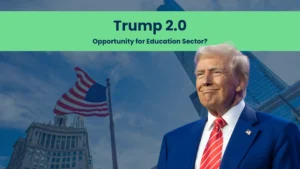The education sector in India presents significant opportunities for growth. With nearly 1.47 million schools, 1,114 universities, and a private education market expected to reach $130 billion by 2030, it is evident that foreign investors are interested. However, to fully leverage this potential, a comprehensive understanding of India’s Foreign Direct Investment (FDI) regulations is crucial.
Importance of India’s FDI Policy in the Education Sector
The inadequate allocation of only 3.1% of India’s GDP towards education highlights the urgent need for increased funding in this sector, as it falls below the target of 6% set forth in the NEP 2020. Foreign Direct Investment (FDI) has the potential to bridge the funding gaps and lift the standards of education in the country.
An investigation into higher education statistics from 2015 to 2016 unveiled that approximately 24.5% of India’s population was registered in tertiary institutions. The analysis also identified a strong correlation between Foreign Direct Investment (FDI) and Gross Enrolment Ratio (GER), suggesting that FDI plays a pivotal role in enhancing educational accessibility.
India’s FDI Regulations in Education Sector
In India, the FDI framework allows for 100% foreign investment in various education services, such as higher education and vocational training, through the automatic route. This means foreign investors can invest in these sectors without prior government approval. However, investments in not-for-profit educational institutions, such as schools and universities, must follow regulations set by the UGC, AICTE, CBSE, and state boards. Moreover, acquiring real estate for campuses may require additional approvals and compliance with state regulations.
Opportunities for Growth & Investment
1. EdTech & Digital Learning
- Low entry barriers with high scalability
- Demand across K-12, test prep, upskilling, and language learning
- Rapid user growth in semi-urban and rural areas
2. Vocational & Skill-Based Education
- Aligned with Skill India and Digital India initiatives
- High demand in Tier 2/3 cities and industrial clusters
3. International Collaborations
- Partnerships with Indian universities for joint degrees and research
- Exchange programs and virtual classrooms expanding post-pandemic
4. Foreign Campuses
- NEP 2020 allows top 100 global universities to establish campuses
- GIFT City offers regulatory and tax benefits for foreign institutions
Overcoming Key Challenges
Although frameworks are in place, foreign investors encounter various obstacles. These challenges include:
- Conflicting Objectives: Critics say that Foreign Direct Investment (FDI) may prioritize profits over social welfare goals, potentially leading to the commercialization of education and a shift towards market-focused fields
- Regulatory Complexity: Complying with overlapping regulations from multiple government bodies can be a major challenge, especially for institutions operating within educational campuses.
- Land and Property Restrictions: Strict conditions govern the acquisition of land and property, particularly for organizations operating as not-for-profit entities.
- Cultural and Governance Challenges: Opposition, particularly from socio-political groups, rooted in concerns regarding foreign influence, poses additional hurdles for foreign investors.
The Road Ahead
The National Education Policy 2020 outlines ambitious goals, including raising the gross enrollment ratio (GER) to 50% by 2035, guaranteeing foundational literacy for all, and establishing the Higher Education Commission of India (HECI) to enhance regulation of both foreign and domestic involvement.
At the same time, room exists for PPP models, EdTech ventures, international research collaborations, and skill-based private institutes to partner with foreign investors and scale rapidly.
Bottom Line: Strategize, Comply, Collaborate
Foreign Direct Investment (FDI) has the potential to tap into India’s growing demand for education, but it necessitates a careful approach that includes following regulations, forming local alliances, and being mindful of social equity objectives. Whether you are an EdTech company, a university, or an investor, you need to:
- Focus on areas with fewer legal hurdles such as digital learning and skill development
- Support the objectives set forth in the National Education Policy (NEP) 2020, which encompass accessibility, equality, and innovation
- Engage in partnerships at the local level to navigate the complexities of land ownership, governance, and regulatory compliance
Ready to tap into one of the world’s fastest-growing education markets? Learn how India Market Entry can guide your investment, expansion, or collaboration journey in India’s education sector today.
—————————————————————————————————————————
Reference Links:
https://sampreshan.info/index.php/journals/article/view/390/219
https://tuljalegal.in/blog/challenges-and-opportunities-in-implementing-fdi-policies
https://www.lexology.com/library/detail.aspx?g=6986fa81-2eb9-4124-b3e2-ace97bba7aba





